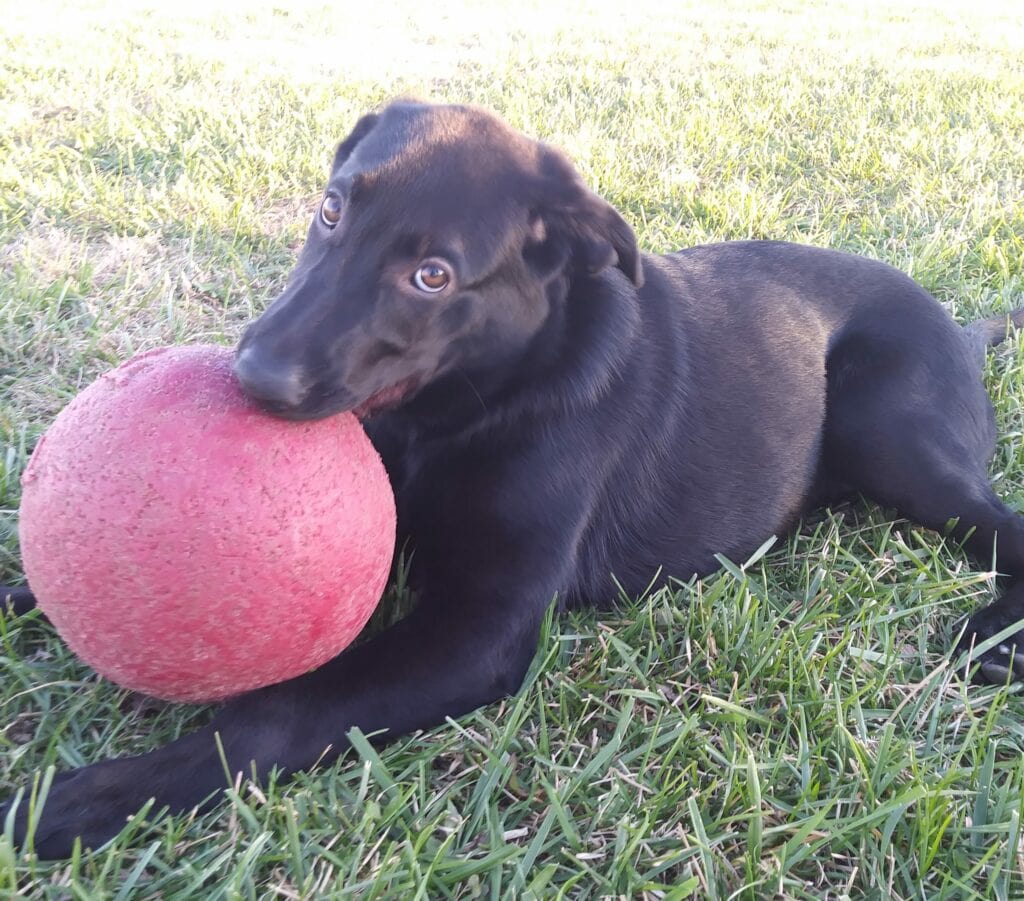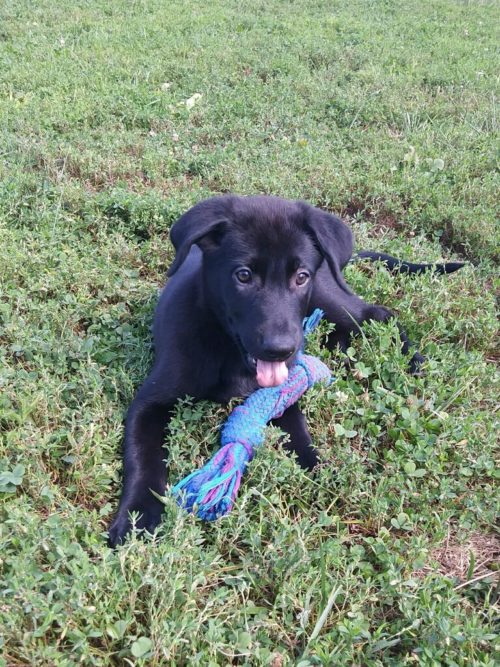
“Sometimes cases come along that challenge our skills, our emotions, our intellect, and sometimes all three! Such is the case with an employee’s dog, an 8 month old Labrador mix named, G.G.
G.G first presented on 2/12 for multiple vomiting episodes and being more lethargic than normal. She was still eating and didn’t seem that bad otherwise, so an injection of an anti-vomiting/nausea medication was given, and she went home to be monitored. She presented the next day for hyper-salivating and now she was not eating. Radiographs (X-rays) were done and there was some possible foreign material noted in the stomach. The owner didn’t know of anything for sure that G.G. had gotten into but she was known to eat things she shouldn’t. She is not alone in this, we have seen MANY dogs for this kind of thing (I battle it with my own two dogs!). Since she didn’t look obstructed on the x-rays she was hospitalized on fluids and medications to see if re-hydrating her would help whatever it was pass. Repeat x-rays were done and there did look like there was improvement in the gas patterns and the stomach seemed to be emptying. On 2/14 she was discharged as she was eating and seemed to be feeling better. Unfortunately, it was not long lived.
G.G came back on 2/16 for more vomiting and not being herself. She was re-hospitalized, and more x-rays were taken. There was one particular area that looked like it could be foreign material and it was not moving all day. She clinically did not seem to be improving so after multiple discussions with the owner we decided to go to surgery that night. I think it is worth saying that exploratory surgeries can be seen as both a diagnostic and therapeutic tool. Sometimes we know that something is in there that we need to get out. But in some cases, we just don’t know and going in is the only way that we can find out for sure. There are times that we will have to open a dog or cat up and we may find what we are expecting, and we might find nothing. While it may seem like a waste it is really not from our end, because then we know for sure that nothing is in there and we can take a good look at the organs to make sure that there isn’t something going on that we couldn’t see. Also, sometimes just being able to “run the bowel” and gently massage the intestines can be the thing that jump starts them into moving if they were not and get a dog eating when it was not. So, while is it nice to always have something to get out, sometimes it isn’t the case but to us it is really never a wasted step.
With G.G we most certainly did not come up empty-handed. It was very apparent when I was able to get in the abdomen that there was a section of very abnormal intestines – they were dilated and red/purple and as I gently tried to exteriorize them I could see areas that had perforated and see some intestinal contents start to ooze out. I could see the end point of whatever the foreign body was because there was normal intestine after it. Behind that I could tell that there was some sort of linear string as part of this foreign material and it was extending back through the intestines and bunching them all up and went all the way up into the stomach. The area of intestines that was involved is a very difficult area to work with – we are talking about the duodenum (that first part that exits the stomach) and the first part of the small intestine (jejunum) where it is more closely attached to the root of the mesentery, the neighboring colon, and body wall along the back.
This is where this case challenged the skills of myself and others who were able to help consult with me. I had to resect part of her intestine from just beyond where her pancreas was down about 8 inches into the jejunum (small intestine). Any resection and anastomosis (R&A) is difficult and more at risk for post-surgical complications by nature, but given where this was occurring I was very worried as to how she would do. I even called the owner to explain how serious things were and that while we have a chance it could very well be that she will have a much harder road after surgery and did they want to continue. They did and so we proceeded with surgery.
The intestine was removed and sewn back up, then the stomach was explored for the string and the other end of the foreign material. It was at that time that it was discovered that the string was trailing upward and out of her stomach and we subsequently found it looped around the base of her tongue! This had to be released and the string was pulled up and out. Now you might ask if the string had been there around her tongue this whole time and why we didn’t see it… good question! My suspicion is yes, it was there this whole time – if it wasn’t then the material that was in her intestine wasn’t really that big and I suspect would have passed through without incident. It was only because the back end was anchored by the tongue and the front bunch of string couldn’t keep going that it started to get taut and bunch things up and ‘saw’ through parts of the intestine and cause problems. As to it going unnoticed, I think that has to do with the anatomy of a dog say compared to a cat which we do see this type of thing in a little more frequently. Compared to cats, dogs have longer, and more mobile tongues and it can be very difficult on an awake dog to manipulate the mouth/tongue in a manner as to easily see under it (even in a very good dog). Cats usually can’t extend their tongue, don’t eat and can’t even lick their nose when the tongue is anchored down. G.G was able to do all of these things and so the string went unnoticed. Even when she was intubated for surgery nothing seemed obviously wrong with her tongue. She did have some ulcerating where the string had cut down into the tongue which ultimately was left to heal on its own after removal. Also, G.G was also just such a sweet, stoic, and good girl that she never really showed the kind of discomfort that I am sure she was feeling. Maybe if she had we would have seen it sooner, but maybe not.
The rest of surgery was completed and then the praying, hoping, and healing began. I will say that G.G completely blew me away post-surgery; by the next day she started to seem more like herself and was eating, no vomiting or regurgitation. She never looked back and had none of the post-surgical complications we worry about with her type of surgery. There is the risk of the anastomosis not holding and falling apart. Since the pancreas was so close to the area of involvement I was worried about pancreatitis and that didn’t occur. She actually had to be boarded at work for a few more days to make sure she was quiet enough to keep healing because she was back to her very happy excited and not quiet self! Ultimately, she had her sutures removed on 2/26 and has continue to do very well. Changes have been made at home to make sure she doesn’t get into this situation again. Besides the obvious expense of surgery, the thing is that animals who have had previous surgeries and R&A’s are much HARDER to do surgery on in the future because of all the adhesions that form post-surgery. G.G. is a very lucky girl and was fortunate – but if I never would have to open her up again it would be okay with me. I learned a lot though through G.G and if it happens again to another dog then I can hope that I will be that much more prepared and able to give someone else the same outcome.”
Dr. Jessica Wiehrdt, DVM
